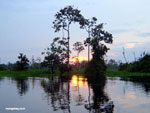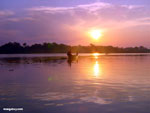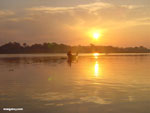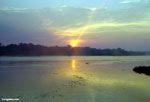Brazil 1999
Amazon -- Rio Negro & Amazon RiverRainforest report for Brazil - from the late 1990s Library of Congress: Brazil Recent mongabay.com articles on Brazil Recommended travel guides on Brazil
Recommended travel guides on Brazil: 


Amazon travel [Wikitravel]: The Amazon is one of the world most diverse biological areas covering about 40% of the South American continent. It is fed by rivers taking their ofspring in the Andes of Colombia, Ecuador, Peru and Bolivia and running into the Atlantic ocean in east Brazil. The Amazon River (occasionally River Amazon; Spanish: Río Amazonas, Portuguese: Rio Amazonas) of South America is one of the longest two rivers on Earth, the Nile River in Africa being the other. The Amazon has by far the greatest total flow of any river, carrying more than the Mississippi, Nile, and Yangtze rivers combined. It also has the largest drainage area of any river system. It may be correctly stated that the Nile is the longest river, while the Amazon is the strongest. The quantity of fresh water released to the Atlantic Ocean is enormous: 184,000 m³ per second (6.5 million ft³/s) in the rainy season. Indeed, the Amazon is responsible for a fifth of the total volume of fresh water entering the oceans worldwide. It is said that offshore of the mouth of the Amazon potable water can be drawn from the ocean while still out of sight of the coastline, and the salinity of the ocean is notably lower a hundred miles out to sea. The main river (which is usually between one and six miles wide) is navigable for large ocean steamers to Manaus. Smaller ocean vessels of 3,000 tons[1] and 5.5 m (18 ft) draft[2] can reach as far as Iquitos, 3,700 km (2,300 miles) from the sea. Smaller riverboats can reach 780 km (486 mi) higher as far as Achual Point. Beyond that, small boats frequently ascend to the Pongo de Manseriche, just above Achual Point. The Amazon drains an area of some 6,915,000km² (2,722,000 mile²), or some 40 percent of South America. It gathers its waters from 5 degrees north latitude to 20 degrees south latitude. Its most remote sources are found on the inter-Andean plateau, just a short distance from the Pacific Ocean; and, after a course of about 7,200 km (4,800 mi) through the interior of Peru and across Brazil, it enters the Atlantic Ocean at the equator Articles involving tourism in Brazil: |
















